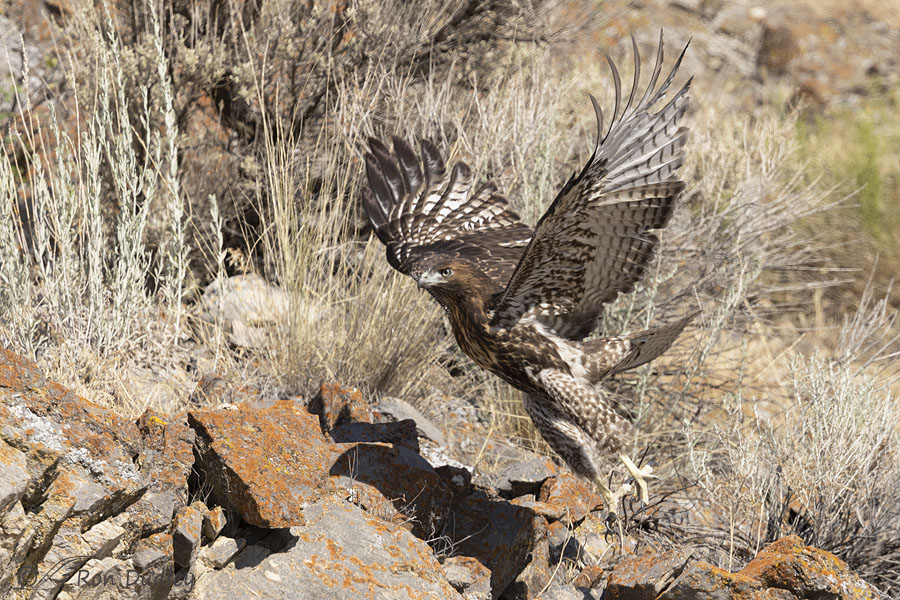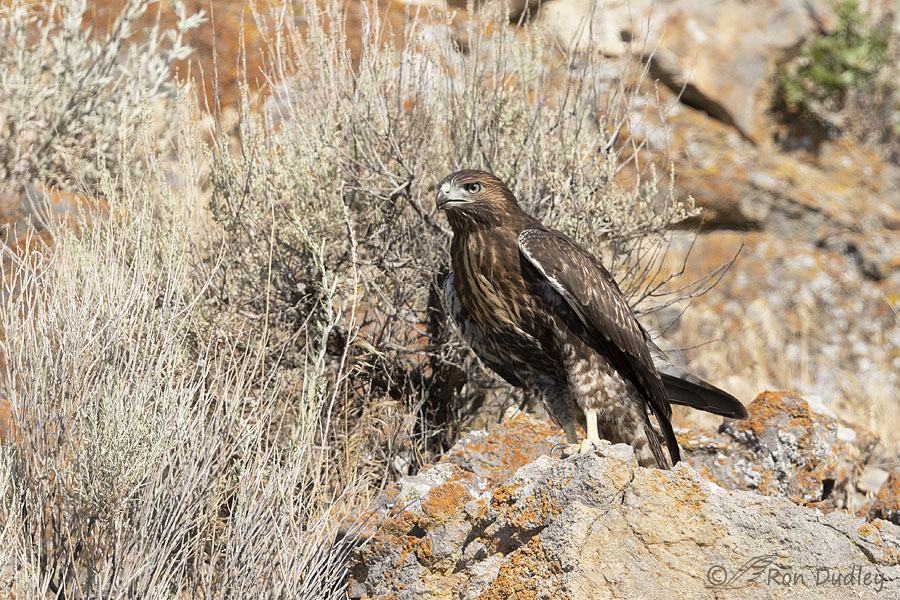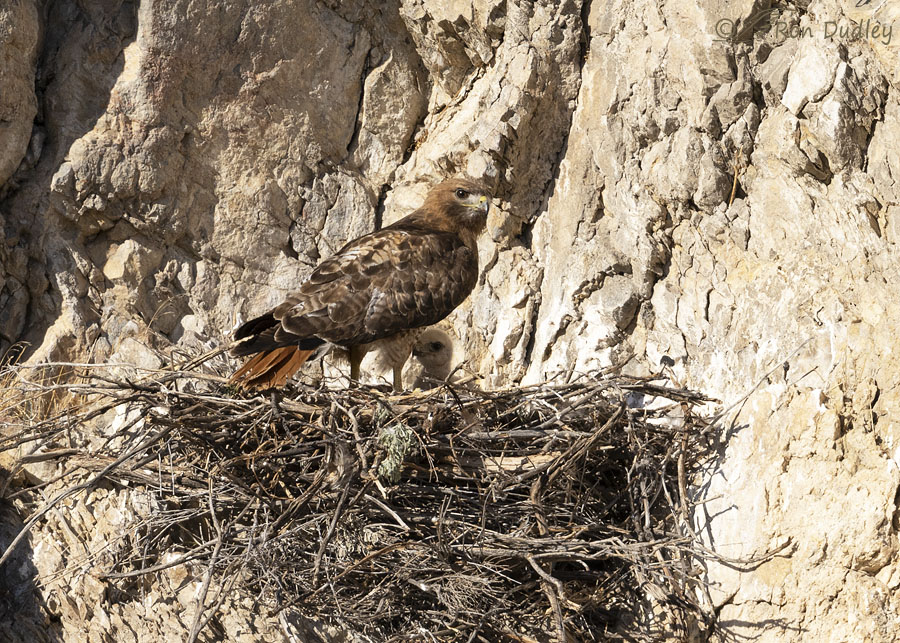A first for me.

1/4000, f/6.3, ISO 800, Canon R5, Canon EF500mm f/4L IS II USM + 1.4 tc, not baited, set up or called in
Two days ago I found this juvenile Red-tailed Hawk perched on a pile of lichen-encrusted rocks in northern Utah. This is a very young bird, fledged only recently, but even at that tender age ‘he’ was smart enough to fool me. There was a steep slope in front of him so when he took off in that direction I figured he’d take off at a pretty steep angle and that’s the direction my lens went when I tried to keep him in frame and in focus when he launched.
But he had other plans.

1/4000, f/6.3, ISO 800, Canon R5, Canon EF500mm f/4L IS II USM + 1.4 tc, not baited, set up or called in
Instead of taking off steeply to avoid the hillside before flying off, he took off at a shallow angle and landed on a rock only about 30′ away from his previous perch and slightly above it. As a result I either clipped wings, or he had his left wing in front of his face or the bird was soft in those few flight and landing shots I managed to get.
Here he’s actually looking at the spot on the side of a cliff he would fly to next so I imagine the purpose of that very short flight was to get a better look at it so he could do some ‘flight planning’. He looks like he’s planning to me.
I’m struck by the beauty of this very dark, young bird.
OK, now we get to the fun part. Followers of Feathered Photography have almost certainly seen this bird before, when he looked very, very different.

Eighteen days ago, on July 1st, I posted this photo of a female Red-tailed Hawk on her cliff-side nest while she was shading her chick from the hot sun. But the photo was actually taken on June 2nd, 46 days ago. I believe the chick in this photo and the juvenile in the previous photos are one and the same bird.
Following are the reasons I think so.
- This nest is where the juvenile flew to when he took off the second time (it’s only a few hundred feet in front of and above where he was perched on the rocks.) I tried to get photos of him while he was on the nest but by the time I got my pickup turned to an angle that allowed me to photograph the nest, he was gone. So, this nest is almost certainly where the juvenile was raised.
- I never visited the nest after June 2nd when this photo was taken but on the three different times that morning when I looked at the nest through my lens I never saw more than one chick. Red-tails can have up to four chicks (usually 2-3), so it’s possible that there were additional chicks in the nest. But I think that’s fairly unlikely, otherwise I’d probably have seen more than one on at least one of the three times I looked at the nest through my lens.
- So, if this juvenile was raised in the nest (which it almost certainly was) and if it had no siblings (which is fairly likely, although not certain), the juvenile I photographed two days ago and the chick in the nest on June 2nd must be one and the same bird.
Even if I’m wrong and there was more than one chick in the nest, there’s still a good chance that the chick and the juvenile are the same bird. I think that’s pretty neat. This is the first time I’ve been able to make such a strong connection (not infallible, but strong) between a young red-tail chick in the nest and the specific fledged juvenile it became.
Ron
Tying up some loose ends:
- On the morning I photographed the juvenile I saw only one other red-tail in the vicinity, on top of a very high cliff perhaps a quarter mile away from the juvenile. It was too far away to identify as a juvenile or adult so I didn’t even try but it’s typical behavior for the adult parents to keep an eye on their fledged offspring from a distance so I suspect it was one of the parents and not a sibling of the bird I photographed.
- In case you’re wondering, Red-tailed Hawk chicks typically fledge 46 days after they hatch.
- I’m aware of several other local bird photographers who have visited the general area of this nest in the past that are also followers of my blog. So, if anyone knows this nest and saw more than one chick in it, I’d like to hear about it.


Cathy is right…cute little fluff ball to “I will hunt you and eat you.”
How cool Ron! and around 45 days is about the time a young hawk would fledge, so I think your case is pretty solid ;-D
I so love your photos…..thank you!
Good to know, Karen. Thanks.
How WONDERFUL. I had a bad, bad night and retired back to bed for a bit after I first got up. It still isn’t dawn here but this sequence and your reasoning (which sound highly probable to me) have me smiling hugely. Thank you.
EC, I hope today is a boatload better than last night was for you. And I’m happy to have contributed to at least get you smiling. Hugely.
Great sequence, Ron. I had no idea they could progress and transform so quickly, your photos make a great illustration (as do so many of your photos!).
Thanks very much, Quentin.
Such beautiful photos Ron. It almost looks like he has the same gaze in photos 2 and 3. It’s really awesome to see the growth and change after 46 or so days. Thanks!
Good point about his gaze, Mark. He may very well have been looking at the nest in both shots.
One word: Gorgeous! And a few more: Thank you for bringing us up to date on this nest, so happy to see the results of the parents’ labor. Though I do wish young RTH had a sibling or two to learn alongside and play with. Makes me wonder if hawk parents treat an “only child” any differently?
Chris, when I posted this last photo on July 1st I think I remember someone asking me to update them on the nest and the chick when I could. I’m thinking it might have been you.
Getting photos of him as a chick and a fledgling is an impressive accomplishment. He looks a bit thin in the take off shot, but fine in the next photo. As we ask with human offspring, do you think this one looks more like the mother or father? Does she have her mother’s nose?
Lyle, this bird may be a chip off the ol block but I don’t know which block…
He is exceptionally beautiful for a RTH. Wonderful to see him at two stages in life.
I’m glad you enjoyed seeing both stages, Kent.
Sensational series Ron!
Charlotte Norton
Thanks, Charlotte.
I certainly believe he could be the lone chick. I have seen Red-tails here have just one chick. He really is a handsome hawk. No ripped up wings or tail feathers or any other imperfections yet. A few years from now he will still be handsome, but maybe not so perfect. Nice shots and message.
Thanks, Everett. I suspect he’ll look more ragged fairly soon. When clumsy young hawks are learning to fly, to land and especially to hunt, it’s pretty hard on their feathers.
What a stunning transformation in such a short time…….must have been
all of the extra food he didn’t have to share, and the parents must also get
a break, when they have only one chick to feed……or, I wonder, do they hunt
at the same rate, and that single chick gets a very large amount of food
when compared to the share it would have if sibs were in the nest ? It must
be extra rewarding for you to be able to follow individuals that you “know” !
I think you’re right, Kris. With only one chick to feed it would be much easier to keep it well fed and healthy. I suspect there were originally several very young chicks in the nest but, especially in this drought with reduced numbers of rodent prey, it’s quite likely that one or more didn’t survive.
“Extra rewarding”? It sure is.
Solid reasoning Ron. Nice photos as well. That really is a dark bird.
Thank you, Michael. Yes, unusually dark. And I think, beautiful.
Beautiful hawk! Always a challenge to figure out what they’re going to do and then they don’t. Luv the dark morphs.
Luv the dark morphs. 
HUGE thunder clap right over the top of us this morning for a “wake up call” with pink/orange sky all around. “Isolated” storm I guess…….
I hope you get some moisture out of it, Judy. Gotta get some water in that creek (oops, I meant crick.)
Very cool, Ron. It never ceases to amaze how quickly raptors transition from adorable little fluff balls to winged predators.
I know what you mean, Cathy. That transformation is both dramatic and quick.